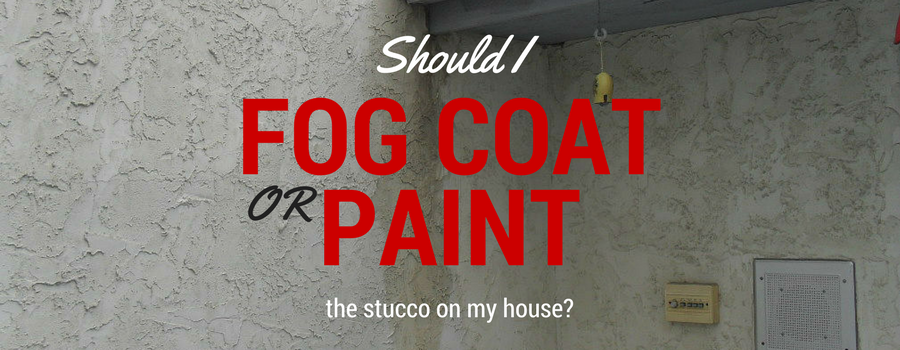
There are a lot of people that are interested in knowing the difference between fog coating stucco walls and painting them. This is a good question because they are both options but have very different characteristics, advantages and disadvantages and other things that you need to know before making a final decision.
Lets take a look at what some of the major differences are between these two materials so you can make a more informed decision about which one is better suited for you.
FOG COAT
Made Out Of: The fog coat is basically made out of three ingredients: white Portland Cement, lime and pigmented color (powder) to match the desired color of the existing stucco.
PAINT
Made Out Of: Paint is generally made from pigments (color), resins, solvents and various additives. If you would like to know more about what these specific items do, here is a helpful article.
Can Be Applied Over: The fog coat can only be applied over traditional cement-based substrates like a traditional stucco finish. It does not do well over painted surfaces or acrylic/synthetic finishes.
Can Be Applied Over: Paint can be applied over virtually any type of surface as long as you are using the correct type of paint for the project. This is what really makes paint standout among other materials in my opinion.
Cost: The cost for the fog coat material can vary greatly depending on which manufacturer you go with because each one has a different yield and cost associated with the material itself. On average, you can expect to pay anywhere from $.02-$.10 per square foot for the material itself.
Cost: The cost per square foot to paint stucco is quite a bit higher than it is to fog coat it because of the cost for exterior paint itself. You can expect to pay on average around $.30-$.50 per square foot for the paint an even higher for better quality stuff.
Colors Available: There are more than 120 colors available for stucco fog coat material, depending on which manufacturer you choose to go with but if you do have to go with one specific company you are quite limited to the selection of around 20 to 40 colors on average.
Colors Available: One of the biggest selling points to paint itself is the ability to make virtually any color you can think of. There are thousands if not tens of thousands of different variations between different manufacturers and the best part is that you don’t have to choose one specific company.
What It Comes In: The fog coat mix for stucco will typically come in a bag (usually 25 lbs.) that is in a powder like form. All you have to do is add water to make it suitable for applying it using a Hudson type of sprayer.
What It Comes In: As we all are well aware paint comes in a liquid form and is usually available in three different sizes which are a quart, a gallon and 5 gallons and all of the mixing is done for us.
How Is It Applied?: After the mix has been watered down and is suitable for application, a pump type sprayer like a Hudson sprayer is used to apply the material to the wall in circular type motions.
How Is It Applied?: Paint can be applied in several different ways which we were are all familiar with and these are using a roller, a paintbrush or some type of sprayer. We can also use a combination of all three.
Typical Yield Of Material: The you can vary greatly depending on the manufacturer and how many coats you are using to cover the wall. Two coats is usually recommended by almost every manufacturer and the average yield for two coats is around 400-1,000 square feet.
Typical Yield Of Material: The yield for paint will vary by manufacturer but I used Behr Paint as a reference just for comparison reasons. It states that a gallon of paint will cover approximately 250-400 square feet but for stucco, I bet it is closer to 300 sq. feet.
Longevity: A properly installed fog coat will last a very long time mainly due to the fact that it actually becomes a part of the stucco surface as opposed to a layer on top of the surface. This allows it to last much longer and is often times many decades.
Longevity: A good quality paint will last several years, typically around 3 to 10 years depending on your climate and usually has to have another coat applied after that time is up to keep your exterior looking fresh.

